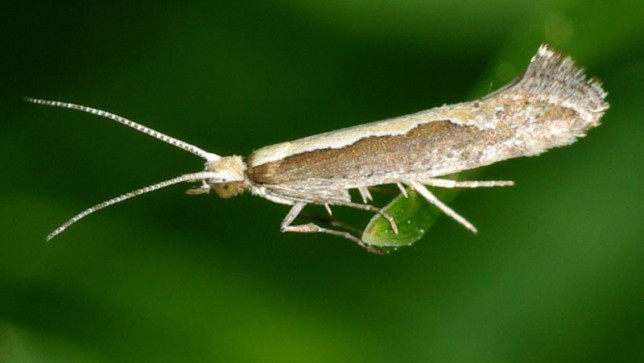Cornell University’s plans to release genetically modified (GM) moths in New York State ignore existing evidence of failure, which shows the GM pests will damage the broccoli and cabbages they are supposed to protect, GeneWatch UK stated Monday.

Diamondback moth caterpillars are agricultural pests which eat brassica crops including cabbages and broccoli. Cornell plans multiple experimental releases of up to 30,000 GM male moths a week, over a two year period, at its New York State Agricultural Experiment Station (NYSAES). The GM diamondback moths are produced by UK-headquartered company Oxitec, which was bought by Intrexon, Inc. for $160 million in 2015, despite its lack of revenue and commercial products.
Oxitec claims its technology builds on the “Sterile Insect Technique”, in which sterile pests are released to mate with wild ones and suppress the population. However, Oxitec’s GM male moths are not sterile, they mate and reproduce. The female offspring of these matings do not die until the larval stage, with male offspring surviving until adulthood. This means that GM caterpillars will contaminate crops where the GM males are released and cause significant damage to the crop that would not occur if the released insects were sterile.
The only scientific paper published on the effects of releasing these GM moths shows that even in greenhouse experiments (which are much more effective than open releases), releases needed to continue for ten weeks to suppress a target moth population, during which crop damage would occur (1). In the reported experiments, GM males were released in ratios of between 10 and 40 GM males to one wild male, to suppress the population. In further experiments including broccoli plants, the paper reports that “Plants were replaced after 4 weeks, or when defoliated due to larval feeding, by cutting them at their base and placing them on the replacement plants to allow larvae to transfer”.
“Cornell’s plans to release these GM moths ignore the only published scientific evidence about them, which shows that significant crop damage will occur” said Dr Helen Wallace, Director of GeneWatch UK.
The planned releases of GM moths by Cornell have been approved by the US Department of Agriculture (USDA APHIS) and the first phase of testing is thought to be imminent. Previous proposals by Oxitec to release GM diamondback moths in the UK (2), GM olive flies in Spain (3) and GM Mediterranean Fruit Flies (Medfly) in Brazil (4) were all halted. These GM pest insects all used the same genetically engineered trait, which kills the female GM pests at the late larval stage. Expert advisors to the European Food Safety Authority also warned about the problem of crop damage in 2010 (5).
Claims by Oxitec that the releases will reduce the use of pesticides also fail to take account of the existence of other pests, which will continue to require spraying in any future commercial use by conventional farmers (6).
“Cornell’s diamondback moth releases are not a credible approach to tackling this pest, the moths are just another GM failure” said Dr Wallace, “The releases are a desperate attempt by a failing company to convince investors that it has a worthwhile product”.
Intrexon reported an operating loss of $35.25 million in the last quarter (7) and a yearly loss of $125m in 2016 (8).
References:
(1) Harvey-Samuel, T., Morrison, N. I., Walker, A. S., Marubbi, T., Yao, J., Collins, H. L., … Alphey, L. (2015). Pest control and resistance management through release of insects carrying a male-selecting transgene. BMC Biology, 13, 49. www.biomedcentral.com/1741-7007/13/49.
The first set of experiments reported in this paper found that ten weeks of releases were needed to suppress the target moth population to zero (page 3 and Figure 1a).The second set of experiments used broccoli plants, which were damaged by larval feeding (although the extent of the damage is not reported). See page 11: “Plants were replaced after 4 weeks, or when defoliated due to larval feeding, by cutting them at their base and placing them on the replacement plants to allow larvae to transfer”.
(2) Oxitec began discussions with UK regulators in 2011, but, after discussions, never submitted an application for release. Frankenmoth: Health fears over plans to release millions of GM insects designed to destroy pests. Daily Mail. 15th December 2011. www.dailymail.co.uk/news/article-2074319/Frankenmoth-Health-fears-plans-release-millions-GM-insects-designed-destroy-pests.html?ito=feeds-newsxml
(3) Notification Number B/ES/13/07. gmoinfo.jrc.ec.europa.eu/gmo_report.aspx?CurNot=B/ES/13/07 (withdrawn by the notifier); Notification Number B/ES/15/06. Available on: gmoinfo.jrc.ec.europa.eu/gmo_report.aspx?CurNot=B/ES/15/06 (consent refused).
(4) Oxitec’s Medfly was approved for release in Brazil in 2014: www.jusbrasil.com.br/diarios/69287490/dou-secao-1-23-04-2014-pg-51 . However, no open releases of GM Medfly have taken place (see e.g. Oxitec’s 2016 PR: www.oxitec.com/oxitecs-medfly-ready-open-field-trials/ ). This is due to concern about fruit damage and contamination, since the female GM larvae would die inside the fruit.
(5) “[Late lethality] implies that the offspring of the mating between the released arthropods and the wild population carry the transgene and survive beyond the embryo stage…For fruit flies such as approach would be detrimental as it would result in significant damage of larvae to the agricultural produce.” Benedict M, Eckerstorfer M, Franz G, Gaugitsch H, Greiter A, Heissenberger A, Knols B, Kumschick S, Nentwig W, Rabitsch W (2010) Defining Environmental Risk Assessment Criteria for Genetically Modified Insects to be placed on the EU Market. Environment Agency Austria, University of Bern, International Atomic Energy Agency. Scientific/Technical Report submitted to the European Food Safety Authority (EFSA). 10th September 2010. www.efsa.europa.eu/en/scdocs/doc/71e.pdf
(6) Imported cabbageworm, cabbage looper and thrips, as well as diamondback moths, all cause perennial pest problems in New York State and the Swede midge is also recognised as a potentially serious pest. nysipm.cornell.edu/organic_guide/cole_crops.pdf
(7) investors.dna.com/2017-08-09-Intrexon-Announces-Second-Quarter-and-First-Half-2017-Financial-Results
(8) investors.dna.com/2017-03-01-Intrexon-Announces-Fourth-Quarter-and-Full-Year-2016-Financial-Results

















